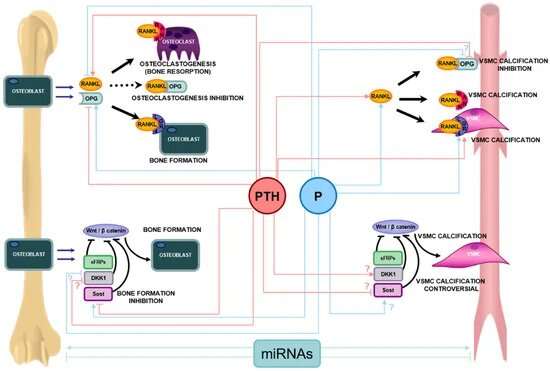
Vascular calcification, low bone mass and fragility fractures are all frequent age-dependent disorders. Recent clinical and experimental data suggest that vascular calcification and bone loss could share pathophysiological mechanisms.
A new review published by the International Osteoporosis Foundation (IOF) Working Group on Bone and Cardiovascular Diseases elucidates the numerous pathophysiological mechanisms shared by the two disorders, identifying the following key associations:
- Vascular calcification is an active process of calcium and phosphate precipitation that involves the transition of the vascular smooth muscle cells (VSMCs) into osteoblast-like cells.
- Among the molecules involved in this process, parathyroid hormone (PTH) plays a key role, acting through several mechanisms which include the regulation of the RANK/RANKL/OPG system and the Wnt/ß-catenin pathway, the main pathways for bone resorption and bone formation, respectively.
- Some microRNAs have been implicated as common regulators of bone metabolism, vascular calcification, left ventricle hypertrophy and myocardial fibrosis.
Professor Jorge B. Cannata-Andia, lead author and Co-chair of the IOF Working Group on Bone and Cardiovascular Diseases, stated:
“This review consolidates current knowledge on how the pathogenesis and progression of vascular calcification and bone loss share several factors and pathways. This question remains: what comes first—is bone loss driving the vascular calcification or the opposite? Or, is there a higher level of dysregulation through aging processes that impacts on both tissues simultaneously but through similar mechanisms?”
In its summary and conclusions, the Working Group underscores the fact that the increase or decrease in tissue and/or serum levels of PTH, the RANK/RANKL/OPG system and the Wnt/bcatenin pathways, calcium, phosphate, FGF23, among the most studied factors, may play a pathogenic role but can also be used as markers of bone and cardiovascular diseases. However, levels of some serum markers should be interpreted with caution, as the correlation between hormone levels and tissue levels needs to be better investigated.
Professor Serge Ferrari, Co-chair of the IOF Working Group and Vice-Chair of the IOF Committee of Scientific Advisors, concluded:
“Better understanding of the shared mechanisms between aging, vascular calcification, and bone loss may ultimately help us to better understand the potential effects of osteoporosis drugs on the cardiovascular system. We hope that this review serves to clarify and summarize current knowledge on the pathophysiology of these common mechanisms, as a stepping stone to further research.”
Source: Read Full Article
